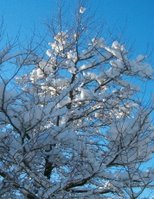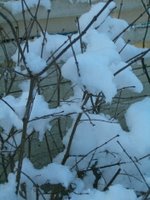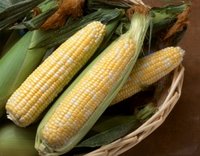





Worrywart John and the Watering Tank
Well, our garden is under snow cover once again, and the temperatures have dropped considerably. We’ve had another major wind storm and our power got knocked out. Half of Gabriola is dark.
We’re not exactly freezing in the dark, since I bought a second-hand generator last summer and it works fine. The two drawbacks are that it is quite polluting (runs on diesel oil) and it makes a hell of a racket.
The main source of heat in our home is a propane stove in the living room, supplemented by base board heaters in the bedrooms. Even the propane stove needs electricity to work, since the thermostat turns it on and off and electric sparks ignite the propane.
I was quite concerned about Eloise and John Down Under, since I read about extensive wildfires in Australia. In fact, 52 firefighters from British Columbia flew down there to help the exhausted Aussies in putting out the fires.
So I sent an e-mail and here is the reply: “Don’t worry about us and wildfires. If anything, we should be worried about floods, we’ve had so much rain. I’m worried that our corn is getting much more than the inch per week of water it needs.”
“So we’ve cut back on the watering and have made our nutrient mix with less water in the past two weeks. This means that our base nutrients, Iguana Juice Grow and Bloom, as well as our supplements, such as Humic and Fulvic Acid, Seaweed Extract, and the root colonizers Piranha, Tarantula, and Voodoo Juice are more concentrated in the watering tank, accounting for a higher EC and PPM reading.”
“John is very concerned about this, since he doesn’t want to burn the tips of our plants with too much Nitrogen, or the other macronutrients. I keep reassuring him that the extra rain will dilute the nutrient mix by the time the roots have a chance to absorb it, but he’s still worried.”
“I should add that John is a worrywart. He worries constantly and there is nothing I can do about it. He worries about the possible major catastrophes that can strike our home and garden, but he also worries about trivial things, such as the rise in the cost of postage stamps—thank goodness for e-mail—and whether the cranberry scones I made for breakfast will disturb his digestion.”
“He also worries about how there are fewer honeybees this year than last. I keep telling him that corn is a monoecious plant, which means that each stalk has both male and female flowers in different locations.”
“As you know, the tassel is the male flower and it’s at the top of the plant. The female flower is located at the junction of leaves and the stem. It is made up of a collection of hairs, known as silks, and enclosed in the husks of what will become the ears of corn.”
“Corn is wind pollinated—it doesn’t rely on insects to transfer the pollen from the tassels to the silks. Had I known all this in such great detail before planting, I would have planted our corn in blocks, rather than rows, since the chances of adequate pollination are greatly increased by doing that.”
“If the pollination is haphazard and not complete, some of the ears will only be partially filled out with kernels, which makes them unmarketable.”
“The sweet corn hybrid that we’ve planted takes about 70 days from seed to harvest. We’re roughly in the middle of the cycle right now, so we’re switching from the vegetative regimen of nutrients, to the flowering stage at the moment.”
“During the flowering stage, Iguana Juice Bloom becomes the predominant source of nutrients for our vegetables. The extras are exactly the same list as during the vegetative stage, but the weekly amounts increase by a large percentage, across the board.”
“Wheras we only put it 375 mL of Grandma Enggy’s Humic Acid into our new 500 Litre pre-mix tank before, now we’re supposed to put 800 mL. As I’ve mentioned before, we’ve cut back on the amount of water in the tank, but the quantities of the mixed ingredients are as if the tank was full.”
“If we did have 500 Litres of water in the tank, the EC reading for week 1 of flowering would be exactly EC 1 or 700 PPM, according to the Bluelab Truncheon CF/EC/PPM meter that is made right here in New Zealand.”
“However, since I urged John to cut back on the water, due to the extra amount of precipitation in these parts, the EC reading went up, which is causing John no end of worry.”
“I keep trying to tell him that it’s okay, that the extra rain will dilute the nutrient mix before it is sucked up by our plants, but he doesn’t listen.”
“I told him to phone the Advanced Nutrients technical support line, and he did. He was told that the EC or PPM numbers are meant to be guidelines only, and that our plants will tell us when we’re feeding them too little, or too much.”
“If our leaf tips turn yellow, they’re getting too much Nitrogen. So let’s say we start off with a Medium Feeding regimen during the flowering stage. Yellow leaf tips mean that we should cut back to light feeding.”
“If the leaves are okay with Medium Feeding, we might be able to increase the amount of food, thus stimulating growth. In this case, we would go to a Heavy Feeding regimen.”
“In corn horticulture, side dressing with fertilizer is recommended. We can simulate this procedure by watering beside the corn stalks rather than right on top of the plants. This will allow for the rain to dilute the nutrients before they are absorbed by the roots.”
“Because of all this rain, our weeds have sprung up like jackrabbits, so I am forever going between the rows of corn with a tiller taking out the weeds and making sure that our corn is safe from the extra pest hazards caused by the proximity of weeds.”
“Another vital ingredient in our watering mix at this time is Carbo Load (Powder) which is designed to boost the sugars that a plant needs during flowering in order to replenish the energy that the reproductive functions deplete.”
“I worry about you and Sara and the kids during your wind storms and power outages. Please let us know that you’re cozy and warm and safe from harm. Love, Eloise.”
posted by Tim at
12:34 PM
![]()

0 Comments:
Post a Comment
<< Home